This review has been a long time coming. Osprey Games sent me Konflikt ’47 to review for my site roughly a month ago. It has taken me a little bit of time to review because I wanted to read the book cover-to-cover before formulating an opinion and sharing that opinion with the world.
First off, this book is gorgeous!!! The artwork within is fantastic and really gets my imagination going! Check out these pictures…
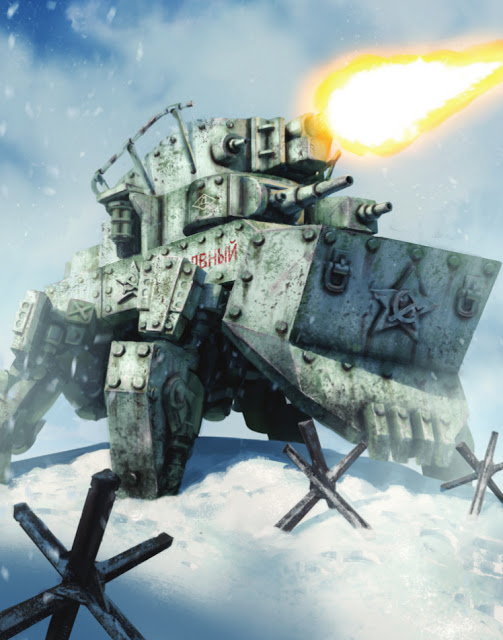
This is a picture of the Soviet’s Mammoth Heavy Walker. For those that follow my blog, they would know from a previous post that I really like the look of this walker and would love to have a Soviet Army centered around this monstrosity. The artwork for this Walker is just awesome! Picture posted with permission from Osprey Games.
This book is full of great artwork like the two examples above. For me, these images really spark my imagination and invoke a strong Weird War feel for the setting. For those that like “fluff,” the book has 21 pages of background information explaining the alternative history of the gaming world. Personally, I would have never read the “fluff” if Osprey had not sent me this book for review purposes. “Fluff” is not normally my thing. Generally, it is the imagery, mechanics and cool looking units that draw me into a game. This book has done well in all of those aspects as well as the “fluff.”
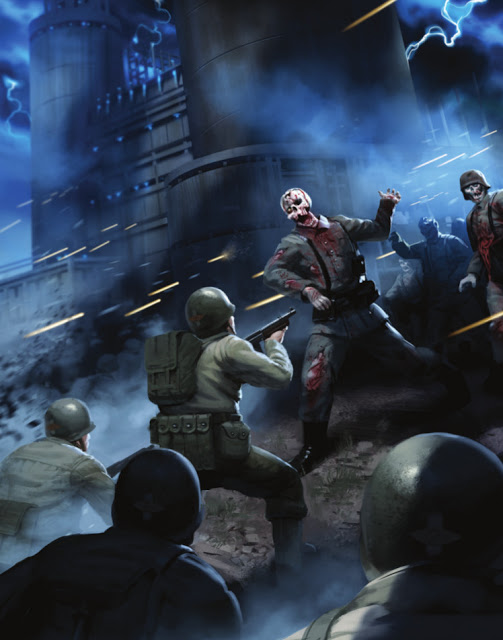
While the Zombie makes this picture a little cartoon like, I think it sets a great atmosphere for the game. The dark castle in the background with American GIs fighting against German Zombies really portrays a Castle Wolfenstein feel that captures my imagination. Picture posted with permission from Osprey Games.
Here is a quick summary of the “fluff” presented in Konflikt ’47. Experiments with Nuclear Weapons open a Rift in the fabric of space to an alternative dimension. Through this Rift comes messages of unknown origins. These messages tell each of the Nations how to upgrade their technology in new and exciting ways to aid them in the war effort. With jealousies around the new technologies, the Soviet Union breaks away from the Allies and goes down its own path. Hitler has similar issues with Japan, but decides to share his technology. There is no army list for the Japanese in this book, but there is “fluff” for them. The Japanese basically take what technology they were given from Germany and make it better. I believe they are slated to be in the next Konflikt ’47 book whenever that may be released.
The rules themselves are very much like the First Edition of Bolt Action. In-fact, I think of this game as Bolt Action 1.5. Are the rules good? Yes. I know for a fact that the rules in Bolt Action: First Edition were very enjoyable. That is part of the reason why over 23,000 copies of the first edition rule-book were sold. To make things more interesting, there are some alterations to the rules for Konflikt ’47.
The most obvious of rule differences between Bolt Action: First Edition and Konflikt ’47 is that surrounding Assault and Reactions in general. The rules have changed so that a unit without an order die already assigned may attempt a reaction to an enemy’s order. Reactions include…
- Go Down (Unit becomes harder to hit – No test required)
- Stand and Shoot (Fire at an assaulting unit)
- Escape! (Run away from an assaulting unit)
- Firefight (Fire at an enemy unit with a Fire order at ranges up to 20″)
- Run to cover (When shot at, a unit may run to better cover or out sight)
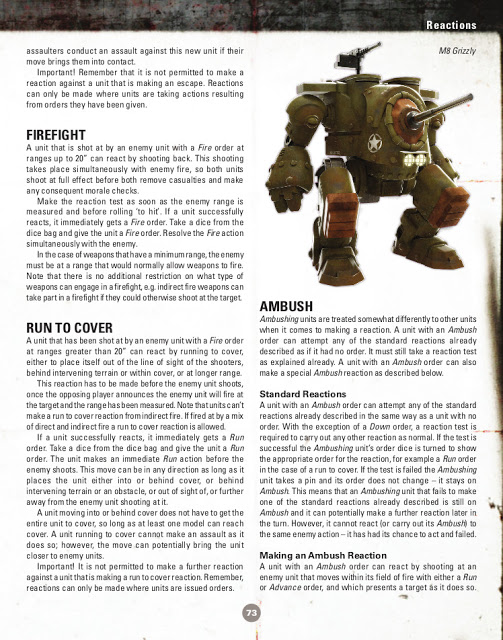
Some of the Reaction Rules in Konflikt ’47. Picture posted with permission from Osprey Games.
This reaction system is quite neat and adds an extra layer of strategy that was not in the original game. It also lends itself nice to what follows in Close Quarters Combat (CQC). When a unit declares an assault, the other unit may attempt a reaction to that assault (either Escape or Stand and Shoot). In assault, there are now two options. A unit may either conduct Point-Blank Shooting or enter Hand-to-Hand Fighting. The assaulting army declares which one they will do before the defender. Point-Blank shooting occurs before Hand-to-Hand Fighting. Point-Blank Shooting is subject to the normal firing rules while Hand-to-Hand is slightly different. In Hand-to-Hand, each pin attached to a unit reduces its attacks by one to a minimum of one die. If combat continues in CQC, all combat is considered Hand-to-Hand after the first round. This dynamic adds another choice in how to deal with assaults. Unlike the original rules, entering into Hand-to-Hand combat does not clear all of the pins off of a unit. The timing of who attacks first is also different in Konflikt ’47 or Bolt Action and something to be aware of for people that wish to play both games. So why place a unit in Ambush with these new reaction rules? Ambush still confers certain bonuses to units that take the order. The most obvious being that with the firefight reaction the attack happens simultaneously with a 20″ range limit whereas Ambush does not have the range limitation and shoots first. Like before, a morale test needs to be made to see if your reaction will go off if you are in Ambush. The same penalty of failing a reaction is also applied when one fails an Ambush roll – the unit takes an extra pin.
Much of the other rules in Konflikt ’47 are very similar to the original Bolt Action. The Force Selection is a little bit different though in that players are allowed to take two Anti-Tank Teams instead of one in Konflikt ’47. The actual units available are also different because there are plenty of new Weird War options to take in Konflikt ’47. A player doesn’t need to take those units to play Konflikt ’47 (a standard Bolt Action army will do), but those new units certainly add flavour. Please refer to my previous posts for more information on what is newly available in each army.
Overall, this is a great book that is well worth a purchase. The artwork is gorgeous, the game is solid and the units are interesting and cool. I especially like the look of the German Heavy Infantry, British Automated Units and the Russian Mammoth.Although it is a fantastic book, I do have some criticisms of Konflikt ’47 that I would like to discuss.
The first criticism is that this book was released very close to the launch date of Bolt Action: Second Edition. If I remember correctly, Konflikt ’47 had just a one to two month head-start on Bolt Action Two. With the two books released so closely, it is my feeling that they should have both incorporated the same core rules. That is, Konflikt ’47 should have been based off of the 2nd Edition Rules. This criticism has been addressed on Warlord Games’ website. Konflikt ’47 was designed and play-tested on the original edition and it is not necessarily intended to be the same game. The guys go further and explain that they are okay with people mashing the two rule sets together if they wish and that they may take the best elements from Bolt Action: Second Edition and apply them to Konflikt ’47 in the future.
I will give it to Warlord that Bolt Action: First Edition was a stand-up game. That said, I did notice a similar discrepancy in the Konflikt ’47 rules to the rules in version one of Bolt Action. In Bolt Action One, these rules were FAQ’d, but the original problem returns in Konflikt ’47. The rule in question is what happens to a weapons team when the person carrying the special weapon is killed. On page 55 of Konflikt ’47, it states under Exceptional Damage that, “If the target is a weapons team, for example a bazooka or medium machine gun team, then exceptional damage indicates that the weapon itself has been damaged or rendered inoperable in some fashion, so remove the weapon and its firer as a casualty.” On page 64 under Team it states, “In the case of a non-artillery team weapon unit – such as a mortar, bazooka, and so on – when the model carrying the team weapon is destroyed, the entire team is considered destroyed. All remaining crew models are removed as casualties and the unit is destroyed.” There is a contradiction here and in the original, the rules as written made snipers overly powerful before the FAQ. In the FAQ of the original, this instant team kill was toned down to just as it is on page 55 (just the soldier and weapon are destroyed and the rest of the squad fight as rifles). It would have been nice if this was caught as it was fixed in the original version but reappears in Konflikt ’47. Once it is FAQ’d, this issue will go away.
The final criticism that I have of the book is questioning whether it should have been released as a supplement book rather than as a core rule-set. I believe that this could have done as a supplement if the company wanted. There is a lot of repeated information from Bolt Action: First Edition. I wonder if the key differences could have been parred down to fit into a theatre sized book. At the same time, I am sure that a sound business decision from Osprey, Warlord and Clockwork Goblin went into making Konflikt ’47 a standalone game.Off the top of my head, I could think of a few good reasons to keep the games separate. I am not saying this is their reasoning, I am just saying that if this is part of the reasoning – I can fully understand the decision.
- To not alienate existing Bolt Action players. There are plenty of players out there that want to keep their games fully historical. Changing the core system to allow Weird units might make those customers want to leave Bolt Action. A while ago, I wrote an opinion piece that touched on both Bolt Action and Flames of War. In it, I discussed the reactions that I get at tournaments (and general gatherings) to my German Flames of War army. It carries an Occult theme. I went further and asked readers how they would feel if I painted a German army in black uniforms for Konflikt ’47 and used that army to double as a Bolt Action army. I received a lot of Internet hate over that article (link to article). By keeping the two games separate (yet compatible), I believe that the publishers can completely avoid the backlash from existing gamers that want keep Bolt Action a “purely historical” game.
- To lower the cost of entry. For those already into Bolt Action, it would cost a few dollars less to sell the book as a supplement, but to a new player, selling the product as a rule-book means that there is just one book to buy. One book to buy means a simpler and more affordable way into the game. I believe that part of the reason for this game is to attract new players that wouldn’t normally be into World War 2. Let’s face it… with Jump Troops, Large Walkers, and Power Armoured Soldiers – it seems like a short stretch for someone to make the leap into this game from another popular gaming system out on the market.
- There is a lot of content in this book. Outside of the core rules, this book contains fantastic full-page artwork along with some new rules, 21 pages of “fluff,” and 72 pages of Army Lists. That is a lot of content to par down into a theatre sized book.
I would like to thank Osprey Publishing again for sending me this great book.

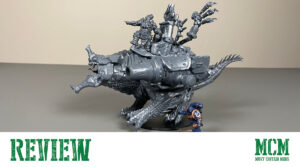
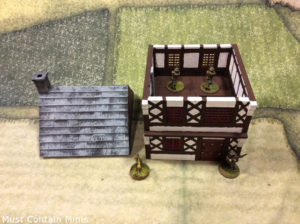

Pingback: Fireteam Zero: Monster Pack A – Minis in the Box | Must Contain Minis
Pingback: Showcase: Kristina Erickson by RAFM | Must Contain Minis
Pingback: Bolt Action: Campaign Sea Lion – Review | Must Contain Minis